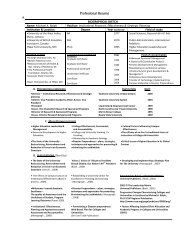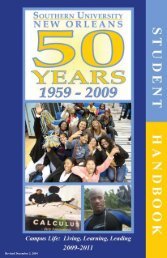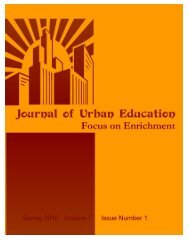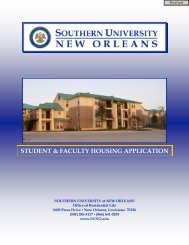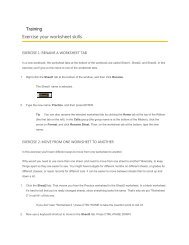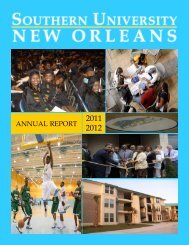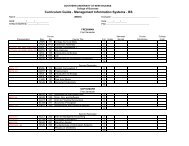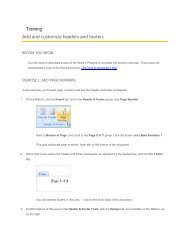Journal of - Southern University New Orleans
Journal of - Southern University New Orleans
Journal of - Southern University New Orleans
- No tags were found...
Create successful ePaper yourself
Turn your PDF publications into a flip-book with our unique Google optimized e-Paper software.
64<strong>Journal</strong> <strong>of</strong> Urban Education: Focus on Enrichmentglobal, to include all cultural constituencies,across race, religion, gender andgeography (http://www.2nature.org).<strong>University</strong> <strong>of</strong> Illinois Outcomes AssessmentCommittee (1999) develops mechanisms forevaluation and assessment <strong>of</strong> the university’sundergraduate and graduate programs andresearch units, and began to place specialemphasis on the assessment <strong>of</strong> student academicachievement as part <strong>of</strong> its accreditationpreparation process. Since then, the studentoutcomes committee has worked to help academicunits to develop assessment plans fortheir majors and to develop assessmentmeasures for the broader, overarching, campus-widelearning goals that are expected <strong>of</strong>university <strong>of</strong> Illinois students, but weightsfaculty involvement can large institutionsdevise effective and efficient program basedassessment plans that will produce resultsbeneficial for all academic units.The National Center for Education Statisticsprovides four conditions under which anoutcomes assessment indicator is considereduseful. First, the indicator must representpractices or conditions. Second, it must reflectprocesses or phenomena that are importantin their own right. Third, a potentially usefulindicator must be able in some fashion tohelp inform policy action either by enablingbroader public understanding <strong>of</strong> a givencondition or by suggesting a mechanism for achange. Finally, all good indicators must becapable <strong>of</strong> universal application and must bevalid and reliable (Corrallo, 19994).Sax, Bryant, & Harper (2005), examined theimpact <strong>of</strong> student-faculty interaction on arange <strong>of</strong> student outcomes including academicachievement, goals, self-confidence, wellbeing,and attitudes-differed for women andmen. The data were drawn from a nationallongitudinal sample <strong>of</strong> college students (N =17,637) who were surveyed upon entry to collegein 1994 and four years later in 1998. Resultsindicate that although many commonalitiesexist in how student-faculty interactionrelates to college outcomes for women andmen, differential effects based on genderwere observed across a number <strong>of</strong> domains.Kuh and Hu (2001) highlight the importance<strong>of</strong> institutional factors, such as selectivity andcontrol, as well as individual characteristics,such as major, gender, race and class standing,when examining student-faculty interactions,and generally support previous findingsthat indicate the educational benefits associatedwith these interactions.Babaoye (2000), Corrallo (1994), Glover andHull-Toye (1995), Townsend (1993), and ahost <strong>of</strong> other scholars support the use <strong>of</strong> transcriptstudy as one fundamental means formeasuring academic achievement. In this regard,the National Center for Education Statistics(NCES) in its publicized work on goodpractice indicators in undergraduate educationsupports the use <strong>of</strong> standardized tests,such as the Graduate Record Examination(GRE), the American College Test (ACT, andthe National Teacher’s Examination (NTE), asgood indicators in their own right, but alsoequally emphasized that they must be complementedwith other methods <strong>of</strong> measuringscholarship achievement. Transcript studiesamong others, are acknowledged as good indicators<strong>of</strong> success.Glover and Hull-Toye (1995), explored therelationship between grade point averagesobtained from students’ transcript as abenchmark for gauging the success <strong>of</strong> schooling.However, the subject <strong>of</strong> assessment <strong>of</strong>student satisfaction with their college experiences,goal attainment, personal growth,and career preparation has enlarged the lensfor viewing the total college experience.Glover concluded that the use <strong>of</strong> transcriptstudies to observe student achievement isimportant because it contains student gradepoint averages and other relevant demographicson the student that may otherwise



